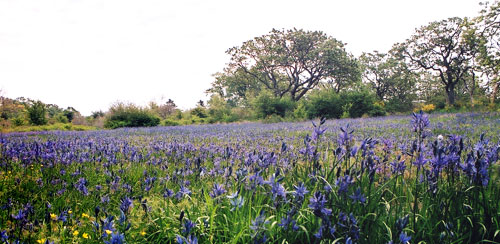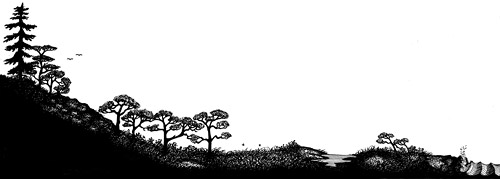What Are Garry Oak & Associated Ecosystems?
A Garry Oak ecosystem is one with naturally occurring Garry Oak trees (Quercus garryana) and some semblance of the ecological processes and communities that prevailed before European colonization. Garry Oaks and their associated ecosystems are found across the traditional, unceded homelands of many Coast Salish Peoples—including the lək̓ʷəŋən Peoples (Songhees and Xʷsepsəm/Esquimalt), the W̱SÁNEĆ Nations, the Hul’q’umi’num’-speaking Nations, and the broader communities whose territories extend down the Salish Sea, from Vancouver Island into Washington State. These Nations actively shaped and continue to steward these oak meadows and woodlands, using practices such as low-intensity cultural burning, weeding, selective harvesting, and seeding to nurture foods, medicines, and biodiversity that continue to sustain their communities and the ecosystem at large.

Garry Oak meadow with camas lilies, Uplands Park (photo by Chris Junck)
The Many Names of Oak
In the English language there are a few colloquial names for the Garry Oak ecosystem, such as Prairie-Oak meadows or Coastal Oak ecosystems. The English name “Garry Oak” refers to Nicholas Garry who was deputy governor of the Hudson’s Bay Company from 1822–1835, yet the name tells only a recent fragment of the story. Across the Coast Salish cultures, the tree and its surrounding habitats are known by older names that reflect relationships that are tens of thousands of years old. Several internet and library resources exist to learn traditional plant names which may vary depending on the location and language spoken. Honouring these names reminds us that Indigenous stewardship is not just historical; it is ongoing and being led by contemporary knowledge keepers and restoration practitioners.
Not Just Trees But Diverse Ecosystems
While individual oaks are majestic, and their retention adds much to the beauty and habitat potential of developed areas, intact Garry Oak ecosystems are a rich mosaic of plant, animal and insect species. Garry Oak ecosystems range from shady woodlands to open meadows with scattered trees, housing a high concentration of terrestrial diversity. Garry Oak trees may be found in mixed stands with other trees, mainly Arbutus (Arbutus menziesii) and Douglas-fir (Pseudotsuga menziesii var. menziesii). Under the shelter of oak canopies or in open meadows, spring wildflowers, grasses, mosses, and a variety of shrubs flourish. Garry Oak ecosystems also support many lichens and fungi, and are home to a variety of mammals, amphibians, reptiles, birds and invertebrates which thrive in these unique environments.
Not Just Ecosystems but Food
While Garry Oak Ecosystems are often lauded for their biodiversity, they can be best understood as culturally tended foodscapes. Camas filled meadows were carefully cultivated in order to be used as a staple food source for sustenance and trade along with acorns, chocolate lilies, berries, and other species that flourished under Indigenous stewardship. Traditional burns were expertly timed to keep shrubs and young conifers at bay, rejuvenate soils, and boosted camas and berry crops. Settler fire-suppression and land conversion disrupted these cycles, yet local Nations are once again leading prescribed-burn programs to revive both ecosystem health and cultural harvests.
Landscapes of Garry Oak and Associated Ecosystems
Garry Oak ecosystems may often be found near, or in combination with, other ecosystems that do not contain Garry Oak trees. These associated sites often share many characteristics with Garry Oak ecosystems, including the cultural cultivation and diverse plants and animals. Some of the species found in associated ecosystems are also common to Garry Oak ecosystems, while some may be restricted to particular habitat types.
Associated ecosystems are highly varied and include rock outcrops and coastal bluffs, maritime meadows and treeless grasslands, along with seasonal wetlands and small pools which disappear during droughts. Also included are transitional forests that have an oak component.
These associated ecosystems share not only biological and ecological characteristics with Garry Oak ecosystems but are also vulnerable to many of the same threats to long-term survival. For this reason, we include associated ecosystems when considering management, restoration and protection of Garry Oak ecosystems.

Garry Oak and associated ecosystems: a spectrum of landscapes.